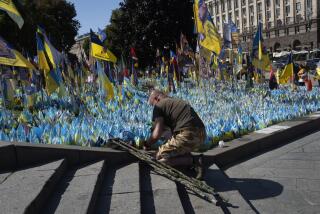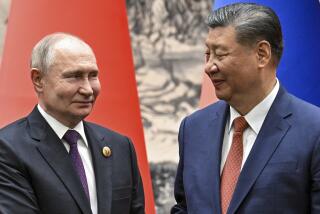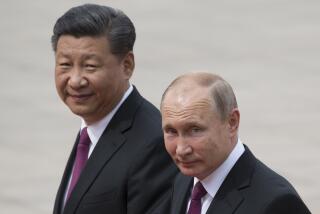Russia flexes military might for sparse crowd of dignitaries on Victory Day
Reporting from Moscow ‚ÄĒ A Western boycott of Russia‚Äôs Victory Day parade Saturday did little to chasten the Kremlin as Russian President Vladimir Putin rolled out fearsome new armor and weapons in a thundering message that might makes right.
In the absence of Russia’s World War II allies who stayed away in protest of Moscow’s intervention in Ukraine, Putin was surrounded at the Red Square event largely by leftist foreign leaders for his display of the military power that has made Russians proud and their neighbors nervous.
Under blue skies and sunshine befitting a postcard, the Kremlin marked the 70th anniversary of the Allied victory over Nazi Germany by parading 16,000 troops, nearly 200 tanks and armored vehicles, truck-mounted ballistic missiles and 140-plus aircraft before thousands of Russian dignitaries, Soviet war veterans and about two dozen foreign leaders.
The Russian military unveiled its new Armata T-14 tank, the first major upgrade of its infantry workhorse in decades. With a 125-millimeter cannon, the tank offers better protection for its operators than the T-72 it is designed to succeed.
The Armata and other new weapons displayed ahead of a roaring aircraft flyover are part of a major rearmament program undertaken by the Kremlin with a projected outlay of $500 billion through this decade.
Some defense analysts say the massive modernization effort is imperiled by the financial crisis gripping Russia, where the ruble has lost about 40% of its value over the past year amid Western sanctions and a sharp drop in oil revenue on which the Russian budget depends. Others, though, say defense and security investments have the highest priority in Putin’s Russia and the costly mission to enhance the strategic arsenal will continue unabated.
Putin brushed off the U.S. and Western European boycott of the parade, blaming the concerted censure on White House bullying of leaders who would have preferred to show their respects to fallen heroes in Moscow. He alluded to the no-shows in a brief address from the reviewing stand in front of Lenin’s Tomb and the crenelated red-brick eastern wall of the Kremlin.
Putin praised the courage and sacrifice of Soviet troops in defeating the Nazis at a cost of more than 20 million lives. He also paid tribute to ‚Äúthe people of Great Britain, France and the United States for their contribution to the victory.‚ÄĚ
But he suggested the absent allies were neglecting their roles as defenders of world peace.
‚ÄúIn recent decades, the basic principles of international cooperation have been ignored ever more frequently,‚ÄĚ he said. ‚ÄúWe see how a military bloc mentality is gaining momentum.‚ÄĚ
Putin has justified his actions involving Ukraine, including the annexation of the Crimean region, with assertions that Russia needs to defend itself against NATO encroachment and what he contends is a U.S.-led plot to oust him from power. Russian officials have portrayed Ukraine’s new leaders as neo-fascists bent on repressing the Russian minority in the country’s eastern regions, where a separatist rebellion has killed more than 6,100 people.
During the 2005 celebrations of the 60th anniversary of World War II’s end, 53 heads of state attended the Red Square festivities, including President George W. Bush and nearly all European leaders.
News agencies reported that 20-some heads of state from among the 68 invited took part Saturday, including those from China, India, Vietnam, Cuba, Venezuela, South Africa and Zimbabwe.
U.N. Secretary Ban Ki-moon was in the official reviewing stand, as were Czech President Milos Zeman and Serbian President Tomislav Nikolic, the only European heads of state known to have broken ranks with the symbolic reprimand.
‚ÄúSerbia will never damage relations with the Russian Federation, even for the sake of becoming a member of the European Union,‚ÄĚ Nikolic told Rossiya-24 television on the eve of the parade, suggesting his country‚Äôs prospects for induction into the bloc may be hurt by his renegade attendance.
Chinese President Xi Jinping was the de facto guest of honor, seated with his wife to the right of Putin. Kazakhstan President Nursultan Nazarbayev, the longest-serving former Soviet republic leader in attendance, was also among the honored guests.
Xi arrived to Moscow on Friday for meetings with Putin and other Kremlin officials to sign the first of a sheaf of trade and economic cooperation agreements expected during his visit that runs through Sunday.
The 80-minute parade kicked off with the chimes of newly renovated Spassky Tower and a goose-stepping honor guard carried Soviet and Russia flags between ranks of soldiers in sharp formation. Many of the units were dressed in World War II replica uniforms and sported the black-and-orange St. George’s ribbons symbolizing Russian war triumphs from both the Soviet and imperial eras.The ribbons have become a symbol of support for Kremlin policy in Ukraine over the past year and were incorporated into the banners and logos of the Victory Day anniversary decorations that fluttered from lamposts and billboards across the country.
Defense Minister Sergei Shoigu rode an open limousine around the sprawling cobblestone square, saluting the troops as he made his way to the dignitaries’ reviewing stand to present the armed forces to Putin and his reported 2,300 guests.
Moscow airspace was closed for nearly an hour during the parade, the Tass news agency said, quoting the Federal Air Transport Agency. Security was tight throughout the capital, with major thoroughfares closed to traffic a mile out from the Kremlin. Many Muscovites watched the massive procession as it made its way from an assembly point five miles northwest of Red Square.
Afterward, a people‚Äôs parade followed, with thousands carrying small flags hailing ‚Äú70 years of victory‚ÄĚ and placards bearing the portraits of forebearers who gave their lives in a war that brought peace - and longlasting divisions - to Europe.
The breakup of the Soviet Union in 1991 spun the 15 republics into independent nations, some now aligned with the European Union and NATO in a shift of allegiance that is fueling Russia’s quest to reassert its authority over its communist- and imperial-era sphere of influence.
Follow @cjwilliamslat for the latest international news 24/7
ALSO:
Iran’s bitter rivalries with Persian Gulf nations taint its watermelons
At 20, Mhairi Black becomes Britain’s youngest member of Parliament
Banned from driving, Saudi women turn to Uber and other ride-share apps
More to Read
Sign up for Essential California
The most important California stories and recommendations in your inbox every morning.
You may occasionally receive promotional content from the Los Angeles Times.











